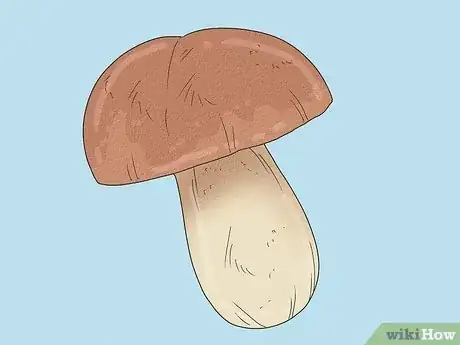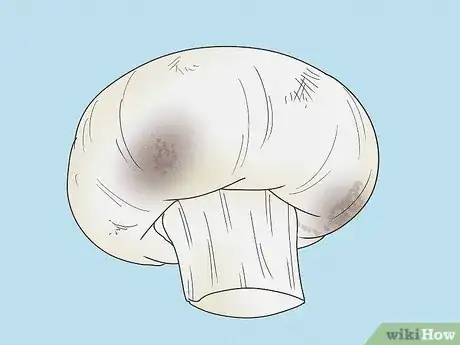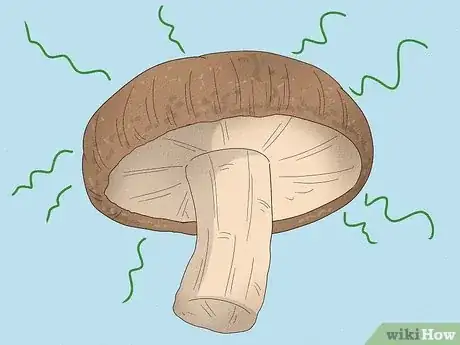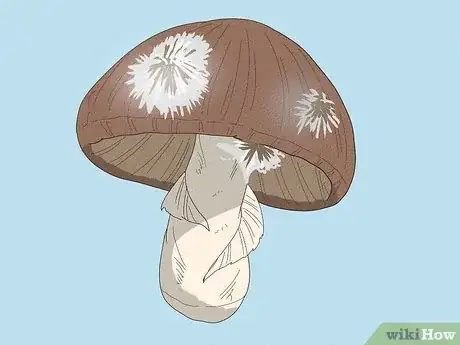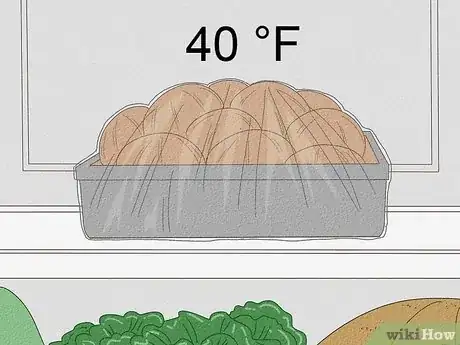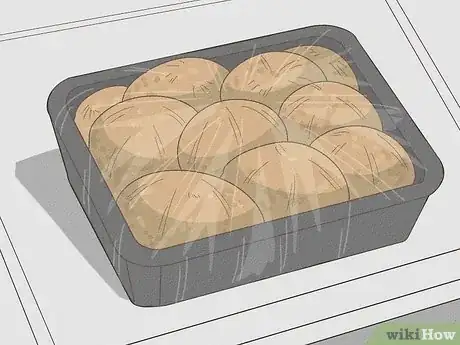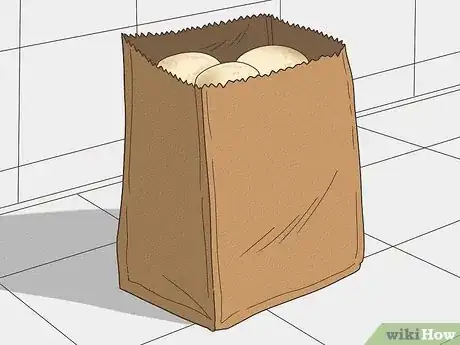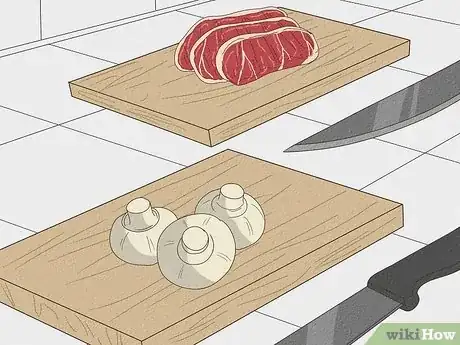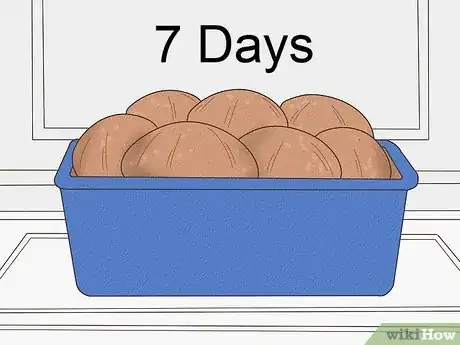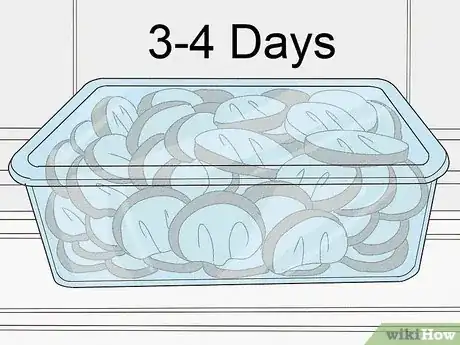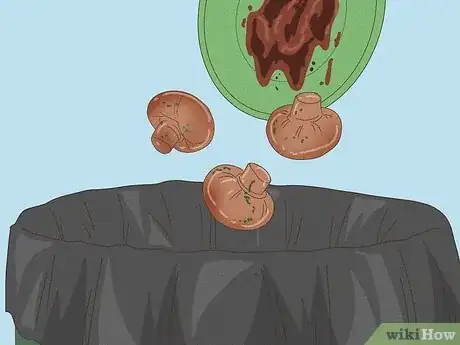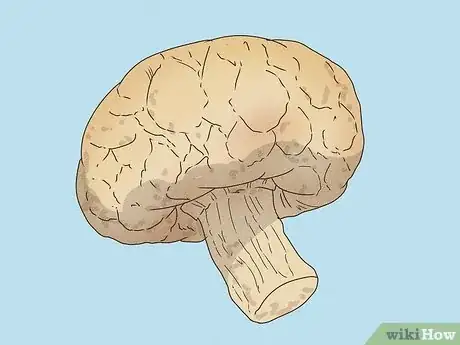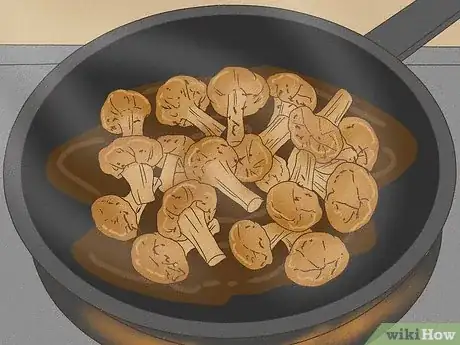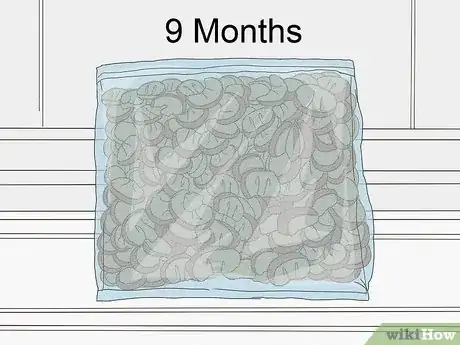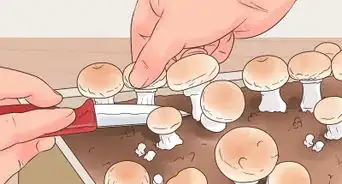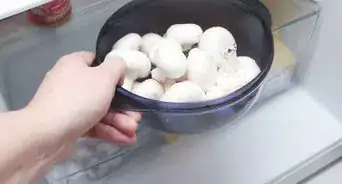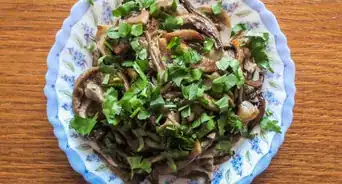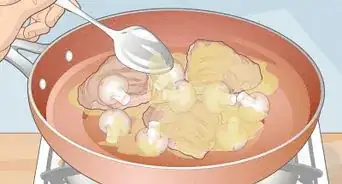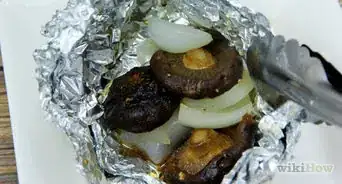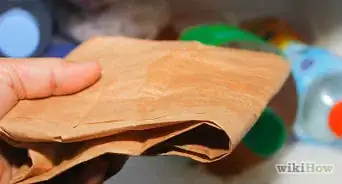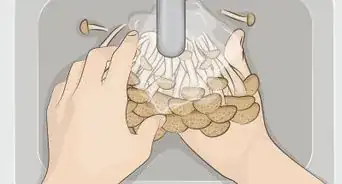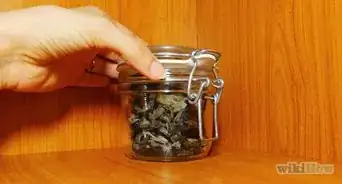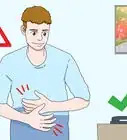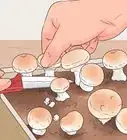This article was co-authored by Ollie George Cigliano and by wikiHow staff writer, Hunter Rising. Ollie George Cigliano is a Private Chef, Food Educator, and Owner of Ollie George Cooks, based in Long Beach, California. With over 20 years of experience, she specializes in utilizing fresh, fun ingredients and mixing traditional and innovative cooking techniques. Ollie George holds a BA in Comparative Literature from The University of California, Berkeley, and a Nutrition and Healthy Living Certificate from eCornell University.
There are 12 references cited in this article, which can be found at the bottom of the page.
This article has been viewed 441,159 times.
You’re getting ready to prepare some mushrooms, but they don’t look as fresh as when you first bought them. Are they still safe to eat? Just like any other food, mushrooms can go bad and eating any that are slimy, smelly, or moldy could make you sick. So before you start cooking, we’ll help you catch tell-tale signs that your mushrooms are starting to spoil. By the time you finish reading, you’ll know how long you can keep mushrooms fresh, and how they’ll look and smell if you should toss them out.
Things You Should Know
- Use mushrooms if they only look slightly dried out or wrinkly.
- Get rid of any mushrooms that look or feel slimy, have brown spots or discoloration, smell fishy or sour, or have developed mold.
- Keep mushrooms in their original packages. Alternatively, put your mushrooms in a paper bag and fold the top loosely.
- Store fresh whole mushrooms in the fridge for up to 7 days. Keep sliced mushrooms for 4–7 days.
Steps
Signs of Bad Mushrooms
-
1Slimy texture Look at the mushrooms to see if they have a coating of slime. If you can’t tell by looking at them, feel the mushrooms to see if they’re wet and slippery. If they don’t feel dry, then throw them away.
- When the mushrooms are slimy, they have lost their flavor and nutritional volume, and there’s a bigger chance there are bacteria on the surface.
Safety precaution: Spoiled mushrooms could contain bacteria that make you sick with food poisoning or botulism. Err on the side of caution and throw away food if you think it’s spoiled.[1]
-
2Bruises and brown spots When it comes to food safety, discoloration is never a good sign. If you notice your mushrooms getting darker in color and developing new spots, then your mushrooms are going bad and shouldn’t be eaten.[2]Advertisement
-
3Sour or fishy smell Fresh mushrooms should smell slightly sweet and earthy, but not foul. If you give them a whiff and they smell fishy or pungent, it’s time to toss them. This means that the mushrooms are too far gone to eat.
-
4Mold growth Look for any spots on the mushrooms or areas inside the package that have a white fuzzy coating. If you see any mold in the entire package, get rid of all the mushrooms so you don’t risk exposing yourself to any harmful bacteria.[3]
- Even if mold only covers a small part, the spores could still have spread to other mushrooms, so they may be dangerous to eat.
Storing Mushrooms Safely
-
1Set your refrigerator’s temperature to 40 °F (4 °C) or lower. Your standard fridge setting is usually cold enough, but check the temperature with a thermometer to be sure. Mushrooms and other perishable items should be stored at temperatures under 40 °F (4 °C). Store mushrooms on one of your fridge’s shelves rather than keeping them in one of the produce drawers.[4]
- Avoid leaving your mushrooms at room temperature since they’re stay fresh longer in the fridge.
-
2Keep pre-packaged mushrooms in their original container. If you’re only using a couple of mushrooms, make a small hole in the packaging at one end of the container. Pick out what you need, then cover the opening with a sheet of plastic wrap.[5]
- The plastic wrap on the original packaging already has holes in it to let the mushrooms breathe so moisture and mold don’t develop inside.
- Avoid putting your mushrooms in any tightly-sealed containers since moisture builds up and leads to mold growth.
-
3Store loose mushrooms in a slightly opened paper bag. Put all of the mushrooms in a brown paper bag and loosely fold the top of the bag over. Your mushrooms will still be able to breathe and the paper bag will help absorb any moisture and prevent mold from growing.
- Alternatively, put your mushrooms in the smallest plastic container they fit in and cover the top with plastic wrap. Poke a few holes in the plastic wrap so the mushrooms can breathe.[6]
-
4Separate mushrooms from raw meat, eggs, and seafood. Keep fresh produce like mushrooms away from any raw items so you don’t cross-contaminate them with bacteria. During prep, use one cutting board and knife for raw meat and another set for your mushrooms and any other ready-to-eat items.[7]
- Keeping mushrooms away from raw meat and seafood is especially important if you don’t plan on cooking the mushrooms.
- Mushrooms also absorb odors so try to store them away from other foods with strong aromas.
Shelf Life
-
1Store whole fresh mushrooms for up to 1 week. Common varieties, such as white, cremini, and portabella mushrooms, are usually safe for about 7 days in your fridge. However, safe storage times depend on how long the mushrooms sat at the grocery store as well. Mushrooms that spent several days at the store may start to go bad within just a few days, so always check your mushrooms before you use them.[8]
- For best quality, purchase the freshest mushrooms possible, and use them within 3 to 4 days. At the grocery store, look for mushrooms that appear plump, firm, and free of any signs of spoilage.
Tip: When you’re grocery shopping, choose whole mushrooms with intact caps and stalks. Broken or bruised mushrooms have a shorter shelf life than undamaged items.
-
2Keep sliced mushrooms for 5 to 7 days. Keep an eye on your mushrooms since different varieties and fridge conditions could cause faster spoilage. Since sliced mushrooms have more surface area, they can spoil up to twice as quickly as whole mushrooms.[9]
-
3Throw away leftover cooked mushrooms after 3 to 4 days. Most cooked foods, including mushrooms, meat, seafood, and veggies, can be stored in the fridge for up to 4 days. If you have some cooked mushrooms you forgot about in your fridge, it’s best to just toss them out so you don’t risk getting sick.[10]
- Be sure to refrigerate all leftovers within 2 hours to prevent mold and bacterial growth. Cooked leftovers should be reheated to a temperature of 165 °F (74 °C) to prevent foodborne illness.
-
4Use mushrooms that are wrinkled or shriveled as soon as you can. If your mushrooms start to develop dry patches and don’t look as plump as they used to, they’re the first signs that your mushrooms are about to go bad. As long as your mushrooms aren’t discolored, slimy, or smelly, they’re still safe to use if you rehydrate them.[11]
-
5Cook most gourmet mushrooms the day you purchase them. Many gourmet mushrooms, such as chanterelles and oysters, can only be stored for 12 to 24 hours before they start to go bad. Since they’re much pricier than buttons or baby bellas, use these gourmet varieties in a meal prompt after you buy them to get the biggest bang for your buck.[12]
- Some gourmet varieties, such as morel and shitake mushrooms, can be stored for 1 to 2 weeks. However, for the best quality, you should still use them as soon as possible.[13]
-
6Freeze cooked mushrooms to preserve them for up to 9 months. Before you freeze your mushrooms, saute them in oil for 5 minutes and let them cool completely. Put the mushrooms into freezer bags with 1⁄2 inch (1.3 cm) of space at the top. Whenever your recipe calls for mushrooms, just take them right out of the freezer and toss them into your dish to heat up.[14]
- Instead of sauteing the mushrooms, you can steam them. Soak the mushrooms in a mixture that’s 1 teaspoon (4.9 ml) of lemon juice and 2 cups (470 ml) of water for 5–10 minutes. Then put them in a steamer basket for 3–4 minutes. Transfer the mushrooms to an ice bath and let them cool.
Expert Q&A
-
QuestionWhat does a good mushroom look like?
 Ollie George CiglianoOllie George Cigliano is a Private Chef, Food Educator, and Owner of Ollie George Cooks, based in Long Beach, California. With over 20 years of experience, she specializes in utilizing fresh, fun ingredients and mixing traditional and innovative cooking techniques. Ollie George holds a BA in Comparative Literature from The University of California, Berkeley, and a Nutrition and Healthy Living Certificate from eCornell University.
Ollie George CiglianoOllie George Cigliano is a Private Chef, Food Educator, and Owner of Ollie George Cooks, based in Long Beach, California. With over 20 years of experience, she specializes in utilizing fresh, fun ingredients and mixing traditional and innovative cooking techniques. Ollie George holds a BA in Comparative Literature from The University of California, Berkeley, and a Nutrition and Healthy Living Certificate from eCornell University.
Private Chef & Food Educator Good, fresh mushrooms are dry and light with an earthy scent—basically, how you would imagine a mushroom to smell. If they smell bad, then they are bad.
Good, fresh mushrooms are dry and light with an earthy scent—basically, how you would imagine a mushroom to smell. If they smell bad, then they are bad. -
QuestionI just cooked up a batch mushrooms with spinach, onion, and garlic cloves. The mushrooms, sliced, were a bit slimy and had dark brown gills. Safe?
 Community AnswerProbably not safe, as two of the most common signs of bad mushrooms are a slimy texture and darkening.
Community AnswerProbably not safe, as two of the most common signs of bad mushrooms are a slimy texture and darkening. -
QuestionHow long after expiration day you can eat mushrooms?
 Joshua ChambersCommunity AnswerDo not eat mushrooms past their expiration date. Fresh mushrooms will keep for 7 days in the fridge. Cooked mushrooms keep for about 10 days.
Joshua ChambersCommunity AnswerDo not eat mushrooms past their expiration date. Fresh mushrooms will keep for 7 days in the fridge. Cooked mushrooms keep for about 10 days.
Warnings
- If you're trying to tell if wild mushrooms are bad, stay on the safe side. Avoid trying to determine whether wild mushrooms are edible or poisonous on your own. Don’t eat wild mushrooms unless a trained mushroom identification professional has given you the okay.[16]⧼thumbs_response⧽
- If you found mold on your mushrooms and you develop shortness of breath, nausea, or a fever, seek medical attention since it could be an allergic reaction.[17]⧼thumbs_response⧽
References
- ↑ https://www.canada.ca/en/health-canada/services/food-safety-fruits-vegetables/mushrooms.html
- ↑ https://www.thekitchn.com/quick-tip-the-best-way-to-stor-1-71328
- ↑ https://health.clevelandclinic.org/what-happens-if-you-eat-moldy-food/
- ↑ https://www.fda.gov/food/resourcesforyou/consumers/ucm114299.htm
- ↑ https://www.thekitchn.com/quick-tip-the-best-way-to-stor-1-71328
- ↑ https://www.thekitchn.com/quick-tip-the-best-way-to-stor-1-71328
- ↑ https://www.fda.gov/food/resourcesforyou/consumers/ucm114299.htm
- ↑ https://digitalcommons.usu.edu/cgi/viewcontent.cgi?article=1183&context=extension_curall
- ↑ https://www.stilltasty.com/fooditems/index/17752
- ↑ https://www.fsis.usda.gov/food-safety/safe-food-handling-and-preparation/food-safety-basics/leftovers-and-food-safety
- ↑ https://www2.ca.uky.edu/agcomm/pubs/FOR/FOR86/FOR86.pdf
- ↑ https://www.thekitchn.com/seasonal-spotlight-pink-oyster-63738
- ↑ http://www2.ca.uky.edu/agcomm/pubs/FOR/FOR86/FOR86.pdf
- ↑ https://www.thekitchn.com/how-to-freeze-mushrooms-23325491
- ↑ https://www.fda.gov/food/resourcesforyou/consumers/ucm114299.htm
- ↑ https://www.poison.org/articles/2009-jun/wild-mushroom-warning
- ↑ https://health.clevelandclinic.org/what-happens-if-you-eat-moldy-food/
About This Article
To tell if your mushrooms have gone bad, look for any wrinkles or dry, shriveled patches, which are the first sign that mushrooms are going bad. If you notice any bruises or brown and black spots on the mushrooms, throw them in the trash, since they could make you sick. Or, if you see a slimy coating on the mushrooms, don’t eat them. You can also tell bad mushrooms from a sour or fishy smell. In general, you shouldn’t eat fresh mushrooms after 10 days of buying them, although some mushrooms can start to go bad after a few days. For more tips, including how to safely store your mushrooms, read on!
